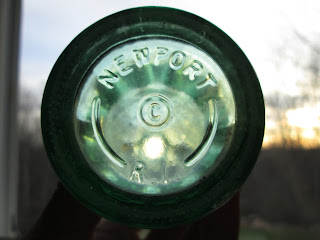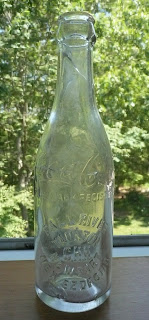Coca-Cola was first bottled in RI starting in the early 1900s. In 1907 Peter Faerber was bottling Coca-Cola in Newport. By 1913 a plant was opened in Providence on Friendship St. A plant in Woonsocket, RI was opened in 1919. These three plants were to be joined by one more in Peace Dale (in the 1940s).
First, I would like to go over a little history on the
chronology of Coca-Cola bottles found in RI, and some of the “bottle lingo”
used to describe them.
The early Coca-Cola bottles from RI are straight-sided. It was not until 1915, when the company had a
competition for a bottle design, that the famous hobbleskirt bottle was
conceived. These straight-sided bottles
were handmade (BIM, or blown in mold) and machine made (ABM, or automatic
bottle machine). The automatic bottle
machine made its debut in 1903, but handmade bottles were still common in the
1910s, and had mostly died off by 1920.
There was more of a lag time for soda bottles due to difficulty
manufacturing bottles with narrow necks using the automatic machines. This issue was resolved in the early 1910s,
but I have yet to see an ABM soda with a date code before 1915.
Straight-sided Coca-Cola bottles can have Coca-Cola embossed in the trademark script style or plain block letters. Only bottles with the script lettering actually had Coca-Cola in them, the other bottles are "flavor bottles", which Coca-Cola used to bottle different flavors of soda.
Straight-sided Coca-Cola bottles can have Coca-Cola embossed in the trademark script style or plain block letters. Only bottles with the script lettering actually had Coca-Cola in them, the other bottles are "flavor bottles", which Coca-Cola used to bottle different flavors of soda.
 |
| 1915 Hobbleskirt Coke |
After the hobbleskirt design was chosen as the new style,
production began in 1918. It was used
until 1928, when the patent expired. The
Dec. 25, 1923 renewal patent was almost identical to the old design (I’m not
very keen on this area, so Coca-Cola experts please bear with me). It was first used in 1928, and last used in
1938. Because of the amusing date,
collectors call these bottles “Christmas Cokes”.
In 1989 Coca-Cola made a large quantity of “retro” Christmas
patent bottles, which are often found with the soda still in them. While they can be easy to mistake as
originals at first glance, there is a very easy way to tell if they are
reproductions. Simply look at the bottom
of the bottle where the town is embossed.
On the reproductions, there will be a circular line connecting the town
and state abbreviation. These bottles
also have a more modern look to them, and are generally devoid of wear or stain
(don’t let all that dust fool you!).
Note: Only Coke bottles with the Christmas patent date and the circular lines are reproductions, newer embossed Coca-Colas have these lines as well, such as the example from Newport below.
Note: Only Coke bottles with the Christmas patent date and the circular lines are reproductions, newer embossed Coca-Colas have these lines as well, such as the example from Newport below.
 |
| A 1950s Coca-Cola, looks similar to a Christmas Repro |
 |
| A D-Pat Newport Coke, with large old style base embossing |
Next up in the timeline are the PAT. D-105529 bottles. This new patent was used from 1938-1951. These bottles can be found marked from every
state and hundreds (if not thousands) of towns.
Collectors refer to these as D-Pat Cokes.
Newer still are the bottles marked US PATENT OFFICE / MIN
CONTENTS 6 FL OZ. These were used from
1951-1958, and the capacity changed to 6-1/2 oz. in 1958. The last embossed Coca-Cola bottles were made
in 1965 (with the exception of more modern retro-style bottles). I will simply call these “USPO” bottles.
In 1965 Coca-Cola finally made the transition to ACL
(applied color label) soda bottles.
First used in the mid-late 1930s, these ACL bottles were hugely popular
in the 1940s-60s. The label on these bottles
was applied in a factory and fused onto the glass with heat. This allowed the bottle to be re-used
multiple times without washing off a paper label. Probably due to the iconic status of the
hobbleskirt Coke bottle, the company was nervous as to how the public would
receive an ACL Coke bottle. After
postponing the transition for more than 25 years, they eventually began using
ACL bottles, and offered them in at least 5 different sizes.
The Providence
plant has a spotty early history. A
shoulder script handmade straight-sided bottle is the only bottle one can find
before 1928. Used from 1910-1919, this
bottle is uncommon, but certainly around.
I strongly believe that when the 1915 patent hobbleskirt design was
introduced, that the Providence
plant simply used unmarked bottles. UPDATE: I was recently able to confirm the existence of a 1915 hobbleskirt Coke from Providence. The
Christmas patent bottles are semicommon, with about 5 per year surfacing on
ebay. One must be cautious, as some of
these are the 1989 reproductions. Once
one reaches the D-Pat bottles, we have the most common RI Coca-Cola
bottle. While wading a river near the
still active plant, I found over 100 Coca-Cola bottles. Most of these were D-Pats, with some of the
newer USPOs. They can be found in just
about every antique shop and bottle dump in RI.
I would value these bottles at $5 in mint condition on a good day, and
$1-3 is normal. The ACL bottles from the
Providence
plant are pretty diverse. Unfortunately
for me, by the time ACL Coca-Cola bottles were introduced, the bottles tended
to travel, and most of the examples I see are from other states. I have come across a few from RI, but the
$10-15 asking prices on most of them have successfully scared me off. I have so far recorded ACLs in the 6-1/2, 10,
16, and 32oz. versions.
The Woonsocket
plant had a short-lived, but interesting run.
Nearly all of the bottles one comes across from this plant are ABM
straight-sided bottles. They all heel
embossed, some in script and some in block letters (flavor bottles). One can also find quart size bottles with
Wyanoke Brand embossed on the shoulder and Coca-Cola (in script or block
letters) on the heel. I haven’t yet
researched what the Wyanoke Brand was, but they are quite hard to come by. One of the toughest RI Coca-Cola bottles to
come by is the 1915 patent hobbleskirt from Woonsocket .
The plant must have closed around 1928, as the 1915 patent bottles were
only made from 1917-1928.
The Newport
plant has the most interesting history.
Peter Faerber, a prolific bottler in the city, made an agreement with
Coca-Cola to bottle it at his plant in 1907.
Perhaps one of the most interesting products of this partnership is a
seltzer bottle. It is etched P. Faerber
Newport, RI on the front (a fairly common RI seltzer bottle to come across),
but the back has Coca-Cola written in red enamel letters. It would certainly be a prize to come across
one of these!
Another mysterious bottle is perhaps one of the rarest RI
Coca-Cola bottles. It is a clear
straight-sided bottle with Coca-Cola embossed in script on the shoulder. The front of the bottle reads: Fall River / Taunton / C.H.H. / Newport
/ New Bedford . I would guess a date of 1915-1920 for this
bottle, which is before many of these towns were known to be bottling Coca-Cola
(Taunton never
had an embossed hobbleskirt bottle, just an ACL). I have been unable to figure out what the
C.C.H. stands for, but it is likely a town or district, or someone’s initials.
Newport Coca-Cola bottles include the Christmas patent
(fairly scarce), the D-pat (uncommon), and the USPO (uncommon). There is also a 10oz. ACL bottle, and very
likely a 6-1/2oz. ACL is out there.
For some reason I have come across a bunch of people who
think that the Christmas Coca-Cola bottles from Newport are tremendously valuable. I have seen them on Craigslist asking $500,
and one Wickford resident thought his dug example was worth $10,000. I must admit, there is a record of one
selling for $93, which is very high for a Christmas bottle. However, I just bought an example (January 2017) for $2, so who knows what they are really worth!
Aside from Coca-Cola, the plant also bottled Newport Club
Beverages in the 1940s-50s. It doesn’t
appear that it was very successful.
The Peace Dale plant was located on Kersey Rd. It operated from the early 1940s in to the late
1960s, possibly the early 1970s. I have
dug a number of the D-pat bottles from this plant, as well as the USPO
bottles. I would consider both of them
to be semicommon. I had a 10oz. ACL
bottle that was accidentally thrown away, and 6-1/2oz. examples have been listed on
ebay.
The Peace Dale plant had its own claim to fame; the
moderately popular South County Beverages brand orange soda. It was introduced around the time the plant
was opened. While not common to find
outside of South County
The plant is now an auto repair shop, but if you go in the
shop, there is a Coca-Cola dispenser where a bottle of Coca-Cola can still be
had for 5 cents.









